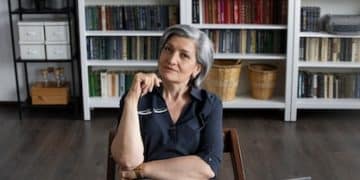Author Event Follow-Up: 4 Steps to Convert Attendees to Loyal Readers

Author event follow-up is crucial for turning attendees into loyal readers; these four steps will help you cultivate lasting relationships and boost your author career by creating meaningful connections with your audience.
Want to transform your author event attendees into devoted readers? The key is a strategic author event follow-up. Let’s explore four actionable steps to convert those fleeting encounters into lasting relationships and unlock the full potential of your author events.
Mastering the Author Event Follow-Up: Why It’s Essential
Author events are a golden opportunity to meet potential readers face-to-face, but the real magic happens in the follow-up. Connecting with attendees after the event can transform casual interest into enduring loyalty, boosting your book sales and building a strong author platform.
A lack of effective follow-up can mean missed opportunities. Think of each attendee as a seed. Author event follow-up is the water and sunlight that nurtures it into a loyal readership. Let’s delve into why it’s a non-negotiable element of your author event strategy.
- Building Relationships: Follow-up creates a personal connection, turning attendees into invested readers.
- Boosting Sales: Targeted follow-up can lead to immediate and future book sales.
- Expanding Reach: Engaged readers can become your best advocates, spreading word-of-mouth enthusiasm for your work.

The impact of author event follow-up is profound. It amplifies the effect of the event, turning temporary interest into lasting loyalty. By mastering this crucial aspect of your author strategy, you set the stage for sustained success and build a community around your books.
Step 1: Capturing Attendee Information Effectively
The first step in an effective author event follow-up strategy is gathering attendee information efficiently. This allows you to connect with individuals after the event, nurture relationships, and turn them into loyal readers.
Collecting contact details can seem daunting, but a well-planned approach ensures you respect attendees’ privacy while maximizing the information you gather. Here’s how you can make it seamless and mutually beneficial:
Creating a Sign-Up System
A digital sign-up sheet is an extremely useful tool for capturing attendee information at an author event. It enables easy data collection and integration into your email marketing system.
- QR Codes: Display a QR code at the event that links directly to your sign-up form.
- Incentives: Offer a small incentive for signing up, such as a free excerpt or a discount on your next book.
- Tablet Stations: Set up tablets at the event for easy sign-up during less busy periods.
Make the sign-up form simple and user-friendly. Request only necessary information, such as name and email address, to encourage more participation.
Step 2: Crafting a Personalized Follow-Up Email Sequence
After capturing attendee information, the next critical step is crafting a personalized follow-up email sequence. This sequence should nurture relationships, provide value, and ultimately convert attendees into engaged, long-term readers.
A well-structured email sequence can set you apart and create a lasting impression, reinforcing the connection made at the event. Here’s how to design an effective follow-up email strategy:
- Immediate Thank You: Send an email within 24 hours thanking attendees for coming to your author event.
- Share Event Highlights: Include photos or a brief summary of the event to remind attendees of the experience.
- Offer Exclusive Content: Provide exclusive content that attendees can’t find elsewhere. This will help you stand out.

Personalizing your follow-up emails can significantly increase engagement. Mention something specific from your conversation or their interests to make readers feel valued. This will make the email sequence more meaningful and relatable.
Step 3: Leverage Social Media to Extend Engagement
Social media is a powerful tool for extending engagement beyond the physical confines of your author events. By leveraging various platforms, you can maintain contact with attendees, foster a sense of community, and drive ongoing interest in your work.
Each platform offers unique opportunities for engaging with your audience. Tailor your content to suit the characteristics of each site, ensuring that your message resonates with a diverse set of followers.
Using different platforms effectively
Using the array of social media platforms to your advantage can enhance every component of the marketing process to ensure that your work reaches the widest possible audience.
- Facebook: Share event photos and thank you notes, encouraging attendees to tag themselves and comment. Use Facebook Live for Q&A sessions following the event to answer any lingering questions from your audience.
- Instagram: Post visual highlights of the event, such as candid shots, book signings, and audience interactions. Use Instagram Stories to share behind-the-scenes moments and quick polls to keep your followers engaged and interested.
- Twitter: Tweet memorable quotes from the event and retweet attendee feedback. Use relevant hashtags to increase the visibility of your posts and connect with a broader network.
This helps expand your reach beyond the physical boundaries of the event, creating an ongoing dialogue with attendees and followers. Ensure that you are responsive and consistent in your interactions.
Step 4: Creating a Long-Term Engagement Strategy
To truly convert event attendees into loyal readers, it’s essential to create a long-term engagement strategy that extends far beyond the initial follow-up. This involves continuously nurturing relationships, providing value, and fostering a sense of community around your author brand.
Building an enduring relationship with your readers requires consistent effort and a genuine interest in their needs and preferences. By investing in long-term engagement, you cultivate a loyal readership that will support your work for years to come.
Here are some effective strategies for maintaining ongoing engagement.
Building an Enduring Relationship with Readers
Building relationships has to be about more than the books. The whole point is to connect your work to the person who is making reading it part of their life.
- Newsletter: Send regular newsletters with updates on your writing projects, sneak peeks of upcoming books, and exclusive content for subscribers. Use your emails to share personal anecdotes, insights into your writing process, and other engaging content that resonates with your readers.
- Book Clubs: Host online or in-person book clubs where readers can discuss your books, share their interpretations, and engage with you and other fans. Book clubs provide a unique opportunity for meaningful interactions and can deepen readers’ connection to your work.
- Reader Community: Build a dedicated online community where readers can connect with each other, share their thoughts and ideas, and participate in discussions. Creating a strong sense of community can foster loyalty and transform casual readers into enthusiastic advocates.
Crafting an Irresistible Author Newsletter
An author newsletter is more than just a marketing tool; it’s a direct line of communication with your readers, a way to share your personality, and an opportunity to provide value that keeps them engaged and excited about your work and make it part of their lives.
A well-crafted newsletter keeps your readers excited and engaged. Focus on what makes you unique as an author. This will set your newsletter apart and keep your subscribers eagerly awaiting each new edition. What unique qualities do you bring to your work?
Here are some effective tips to help you craft an irresistible newsletter:
- Offer Exclusive Content: Subscribers love feeling special and rewarded. Provide value in the form of exclusive content, such as excerpts from upcoming books, short stories, behind-the-scenes insights, or bonus chapters. Make sure the content you provide is high-quality and relevant to your audience’s interests.
- Personalize Your Message: Use your readers’ names and personalize the content based on their preferences. Segmenting your audience based on their interests or past purchases can help you tailor your messages for maximum impact. A personal touch goes a long way toward building loyalty and making your readers feel valued.
- Maintain a Consistent Schedule: Consistency is key to keeping your newsletter top of mind. Determine a realistic schedule for sending out your newsletter, whether it’s weekly, bi-weekly, or monthly, and stick to it. Consistency creates anticipation and helps your subscribers look forward to receiving your updates.
An engaging newsletter is the key to establishing an intimate link with your audience, transforming them from casual readers into lifelong followers invested in your literary journey.
| Key Point | Brief Description |
|---|---|
| 📝 Capture Info | Collect attendee data at events using sign-up sheets. |
| 📧 Follow-Up Emails | Send personal thank you notes and event highlights. |
| 📱 Social Media | Engage event attendees through social media posts. |
| ⭐ Long-Term Engagement | Continue building relationships through newsletters and book clubs. |
What are the best ways to capture attendee information?
▼
Use QR codes linked to digital sign-up forms and offer small incentives to those who sign up. Set up tablets for easy sign-up during less busy event periods to capture more information efficiently.
▼
Send an immediate thank you email, share event highlights with photos, and offer exclusive content that attendees can’t find elsewhere. Personalize each email for greater engagement with your audience.
▼
Share event photos, tag attendees, and use platforms like Facebook Live for post-event Q&A sessions. Post visual highlights on Instagram and tweet memorable quotes to engage with a wider network.
▼
Send regular newsletters with exclusive content, host online book clubs to discuss your books, and build a dedicated online community where readers can connect and share ideas to foster loyalty.
▼
Offer exclusive content, personalize your message, and maintain a consistent schedule. Focus on unique elements that represent your author brand and make each newsletter a valuable experience for your readers.
Conclusion
By implementing these four key steps – capturing attendee information, crafting personalized follow-up emails, leveraging social media, and creating a long-term engagement strategy – you can effectively convert author event attendees into loyal readers, fostering a supportive community around your work.
![Author Spotlight: Unveiling [Author's Name]'s Writing-Life Balance Author Spotlight: Unveiling [Author's Name]'s Writing-Life Balance - Cover Image](https://noveltiesnew.com/wp-content/uploads/2025/06/noveltiesnew.com_3_1750100051_30a4b85f_cover-360x180.jpg)

![Author Spotlight: [Author's Name]'s Top 3 Writing Tips for 2025 Author Spotlight: [Author's Name]'s Top 3 Writing Tips for 2025 - Cover Image](https://noveltiesnew.com/wp-content/uploads/2025/06/noveltiesnew.com_3_1750099356_ebf5848c_cover-360x180.jpg)


![Author Spotlight: Boost Your Book Sales Like [Author's Name] Did! Author Spotlight: Boost Your Book Sales Like [Author's Name] Did! - Cover Image](https://noveltiesnew.com/wp-content/uploads/2025/06/noveltiesnew.com_3_1750098593_c403dfb7_cover-360x180.jpg)